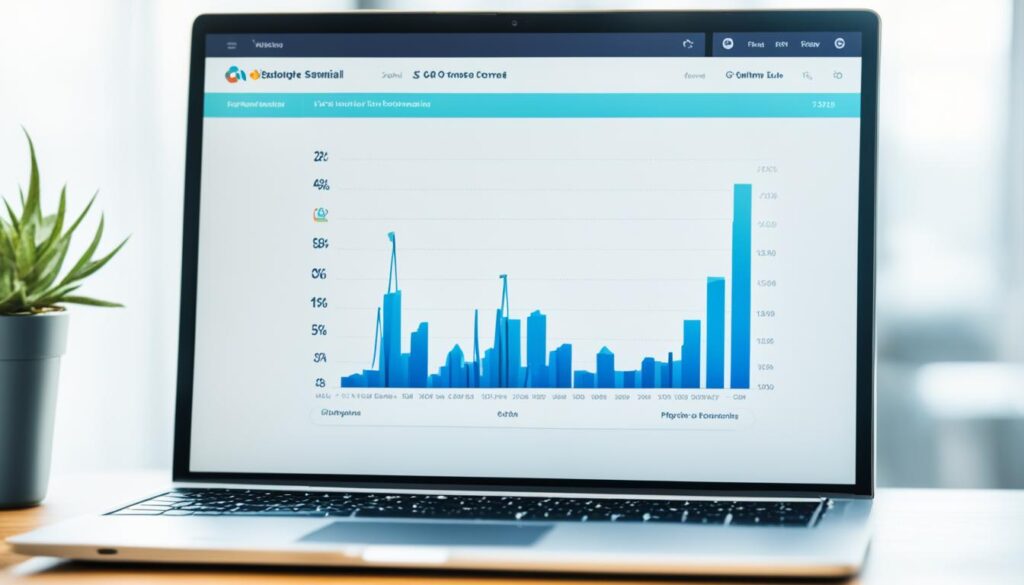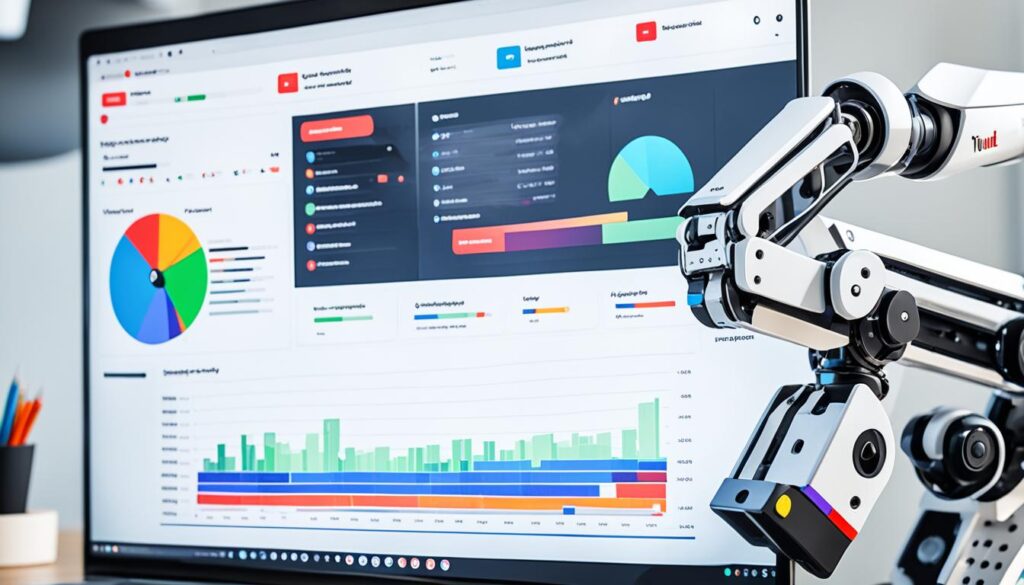Imagine a world where you can thrive in the world of affiliate marketing without the pressure of building a massive social media following. You’re probabl wondering can you do affiliate marketing without social media? And I’m here to tell you that it’s not only possible, but also achievable.
Whether you have no followers, a small audience, or simply want to explore alternative avenues for affiliate marketing, I’ve got you covered. From leveraging organic search traffic through SEO to building an email list that connects directly with your audience, there are countless ways to thrive in this industry without being a social media superstar.
Getting Organic Traffic through SEO
The best way for how to do affiliate marketing without followers is by getting search traffic through SEO.
One way to succeed in affiliate marketing without social media is by getting organic search traffic through SEO. By optimizing your website for search engines and creating high-quality content, you can attract targeted visitors who are actively searching for the products or services you are promoting,
Creating an affiliate marketing website is the first step. Choose a niche market, research relevant keywords, and build a website that provides valuable information and resources related to your chosen niche. This will help you establish your website as an authority in the field and attract organic traffic.

One effective strategy for attracting organic traffic is to create product roundups, product reviews, and how-to guides. These types of content not only provide valuable information to your audience, but they also present opportunities for including affiliate links to the products you are promoting, which is the best way for how to do affiliate marketing without social media. For example, create a product roundup of the “Top 10 Kitchen Gadgets” and include affiliate links to each gadget in the roundup.
By optimizing your content for SEO, including relevant keywords in your titles, headings, and throughout your content, you can improve your website’s visibility in search engine results pages. This will increase the likelihood of your website being visited by users searching for the products or information you offer, allowing you to do affiliate marketing without being an influencer.
In addition to optimizing your content, it’s important to focus on other SEO techniques such as improving the loading speed of your website, optimizing your website’s metadata, and building high-quality backlinks to your website. These strategies will help search engines recognize your website as valuable and trustworthy, leading to higher rankings and increased organic traffic.
Benefits of Getting Organic Traffic through SEO
1. Free and sustainable source of traffic
2. Relevance and targeting – attracting visitors who are actively searching for your products or information
3. Establishing your website as an authority in your niche
4. Opportunities to include affiliate links in content that provides value to your audience
Drawbacks of Getting Organic Traffic through SEO
1. Requires time and effort to optimize your website and create high-quality content
2. Competition for search engine rankings
3. Constantly evolving SEO algorithms and best practices
By focusing on SEO and attracting organic traffic, you can successfully drive targeted visitors to your affiliate marketing website and increase your chances of earning affiliate commissions. Remember to consistently optimize your website, create valuable content, and stay up-to-date with SEO trends to maximize your success.
| Pros of Getting Organic Traffic through SEO | Cons of Getting Organic Traffic through SEO |
|---|---|
| Free and sustainable source of traffic | Requires time and effort to optimize your website and create high-quality content |
| Relevance and targeting – attracting visitors who are actively searching for your products or information | Competition for search engine rankings |
| Establishing your website as an authority in your niche | Constantly evolving SEO algorithms and best practices |
| Opportunities to include affiliate links in content that provides value to your audience |
Buying Traffic through SEM or Paid Social Media Campaigns
Looking to drive targeted traffic to your affiliate offers without relying on social media? Buying traffic through SEM (Search Engine Marketing) or paid social media campaigns can be an effective strategy. While it may require an upfront investment, this approach can yield quick results and help you generate affiliate commissions.
One advantage of paid traffic is the ability to reach a specific audience interested in your niche or high-ticket affiliate products. With SEM, you can bid on relevant keywords and have your website or landing page appear in search engine results, capturing the attention of potential buyers actively looking for products or information, which is a great way for how to start affiliate marketing with no audience.
Paid social media campaigns also offer a powerful way to promote your affiliate offers. Platforms like Facebook, Instagram, and Twitter provide advanced targeting options, allowing you to reach users based on demographics, interests, and behaviors. By refining your audience targeting, you can maximize the chances of converting paid traffic into affiliate commissions.
When implementing this strategy, it’s crucial to choose the right high-ticket affiliate products that offer attractive commissions. Selecting products with a proven track record of conversions and high demand can increase your chances of earning significant affiliate commissions.
To optimize your paid traffic campaigns, consider implementing A/B testing to identify the most effective ad creatives, headlines, and calls-to-action. Continuously monitor and analyze your campaign performance, making adjustments as necessary to improve your return on investment (ROI).
Remember, success with buying traffic through SEM or paid social media campaigns requires a solid understanding of paid advertising principles and strategies. It’s important to educate yourself on campaign optimization techniques, ad targeting options, and bidding strategies to make this approach profitable, making it a great way for how to do affiliate marketing without a following.
Why SEM and Paid Social Media Campaigns are Advantageous:
- You can reach a specific audience interested in your niche or high-ticket affiliate products.
- Advanced targeting options help you refine your audience and increase conversion potential.
- SEM allows you to capture the attention of users actively searching for products or information in search engine results.
- Paid social media campaigns offer extensive reach and the ability to engage with potential buyers directly.
Considerations for Successful SEM and Paid Social Media Campaigns:
- Select high-ticket affiliate products that offer attractive commissions.
- Implement A/B testing to optimize ad creatives, headlines, and calls-to-action.
- Monitor and analyze campaign performance to improve ROI.
- Stay updated with paid advertising trends and techniques to maximize your success.
| Pros: | Cons: |
|---|---|
|
|
By leveraging SEM or paid social media campaigns, you can drive targeted traffic to your affiliate offers, increasing your chances of earning affiliate commissions. Remember to choose the right products, optimize your campaigns, and stay informed about the latest trends and techniques in paid advertising to make this strategy profitable.

Building an Email List
One of the most effective strategies for succeeding in affiliate marketing without relying on social media is building an email list. By collecting email addresses from your website visitors and implementing targeted email marketing campaigns, you can directly promote affiliate products to your audience, driving affiliate commissions and increasing your revenue.
An email list allows you to establish a direct line of communication with potential buyers, enabling you to nurture relationships, provide valuable content, and offer exclusive promotions. With an engaged subscriber base, you have the opportunity to build trust, showcase your expertise, and ultimately drive conversions.
Here are the key steps to building an email list for successful affiliate marketing:
- Create an opt-in form on your website: Embed an opt-in form on your website to capture email addresses. Offer a compelling incentive, such as a free ebook or exclusive content, to encourage visitors to subscribe to your list.
- Segment your subscribers: Categorize your subscribers based on their interests, preferences, or any other relevant criteria. This allows you to send targeted emails and personalized recommendations, increasing the likelihood of conversions.
- Use email marketing software: Invest in a reliable email marketing software that provides features like automation, personalization, and analytics. This will help you streamline your email campaigns, track their performance, and optimize your strategies for better results.
- Create valuable content: Regularly send valuable content to your subscribers, such as informative newsletters, product recommendations, and exclusive discounts. Focus on providing solutions to their pain points and showcasing the benefits of the affiliate products you promote.
- Include affiliate links in your emails: Strategically insert affiliate links within your email content, ensuring they are relevant and beneficial to your subscribers. Make sure to disclose your affiliate partnerships transparently and adhere to the regulations set forth by the Federal Trade Commission (FTC).
Building an email list enables you to establish a loyal and engaged audience that is more likely to convert. It provides a direct channel for promoting affiliate products, earning affiliate commissions, and strengthening your online presence.
Tips for Effective Email List Building
To optimize your email list building efforts, consider incorporating the following strategies:
- Create compelling lead magnets: Develop valuable incentives that resonate with your target audience, such as exclusive video tutorials, comprehensive guides, or access to a members-only community.
- Optimize your opt-in forms: Place opt-in forms strategically on your website, utilizing engaging copy and eye-catching design. Test different placements, sizes, and formats to maximize conversions.
- Offer content upgrades: Enhance your blog posts or articles with additional resources or extra insights, accessible only to email subscribers. This provides an incentive for readers to subscribe to your list and receive exclusive content.
- Run contests or giveaways: Host periodic contests or giveaways where participants must provide their email addresses to enter. This can help attract new subscribers and generate buzz around your affiliate promotions.
By implementing these strategies, you can rapidly grow your email list, nurture your subscribers, and boost your affiliate marketing success.

Comparison of Top Email Marketing Software
| Email Marketing Software | Features | Pricing |
|---|---|---|
| 1. Mailchimp | User-friendly interface, automation workflows, A/B testing | Free plan available, paid plans start at $9.99/month |
| 2. AWeber | Segmentation options, autoresponder sequences, robust analytics | 30-day free trial, paid plans start at $19/month |
| 3. Constant Contact | Drag-and-drop editor, social media integration, event management | 30-day free trial, paid plans start at $20/month |
| 4. GetResponse | Responsive email design, landing page builder, advanced automation | 30-day free trial, paid plans start at $15/month |
Choose an email marketing software that aligns with your specific needs and budget. Conduct thorough research, compare features, and read customer reviews to make an informed decision for your affiliate marketing campaigns.
Starting a Blog
Starting a blog or website is an effective method for affiliate marketing without relying on social media. With your own blog, you have the freedom to create evergreen content that is optimized for search engines, helping you attract organic traffic to your website. By implementing SEO optimization techniques, you can ensure that your blog ranks high in search engine results, increasing your visibility and potential for affiliate sales.
One of the key advantages of starting a blog is having complete control over your content. You can create engaging articles, tutorials, and reviews that resonate with your target audience. This allows you to build trust and authority, establishing yourself as an expert in your niche.
When creating blog content, consider incorporating affiliate links seamlessly into your posts. By strategically placing affiliate links within relevant articles, you can introduce your readers to valuable products or services and earn affiliate commissions.

Benefits of Starting a Blog for Affiliate Marketing without Social Media
1. Long-term Success: Building a successful blog takes time and effort, but it can lead to long-term success. By consistently publishing high-quality content and optimizing it for search engines, your blog can continue to attract organic traffic and generate affiliate income even when you’re not actively promoting it.
2. Monetization Opportunities: A blog provides various opportunities for monetization. In addition to affiliate marketing, you can explore other revenue streams such as display ads, sponsored content, and even creating and selling your own products or services.
3. Establish Authority: Through consistent blogging, you can position yourself as an authority in your niche. This can open doors to collaboration opportunities with brands, influencers, and industry experts, further expanding your reach and potential for affiliate partnerships.
4. Sellable Asset: A successful blog with a loyal audience and consistent traffic can be a valuable asset. If you decide to venture into other opportunities or simply move on from affiliate marketing, you can potentially sell your blog for a profit.
Affiliate Marketing Success Tips for Your Blog
1. Focus on Evergreen Content: Create content that remains relevant over time. Evergreen content continues to bring in traffic and generate affiliate sales long after it’s published. This includes how-to guides, product roundups, and in-depth reviews.
2. Implement SEO Strategies: Optimize your blog posts with relevant keywords, meta tags, and quality backlinks. This will improve your blog’s visibility in search engine results and increase the likelihood of attracting organic traffic.
3. Build a Strong Network: Connect with fellow bloggers, influencers, and industry professionals in your niche. Building relationships and collaborating with others can expose your blog to new audiences and potential customers, boosting your affiliate marketing efforts.
| Affiliate Blogging Do’s | Affiliate Blogging Don’ts |
|---|---|
|
|
Using Paid Ads
One effective strategy for generating affiliate commissions without relying on social media is to use paid ads. Paid advertising campaigns, such as PPC ads, can drive targeted traffic to your affiliate offers, increasing your chances of earning high commissions. To make the most out of your paid ads, it’s crucial to choose high-ticket affiliate offers that offer attractive commission rates and optimize your landing page to maximize conversions.
With paid ads, you have the advantage of reaching out to a specific audience who are actively searching for products or services related to your affiliate offers. This targeted approach can significantly increase the likelihood of generating sales and earning substantial commissions.
When running paid advertising campaigns, it’s important to carefully plan and monitor them to ensure a positive return on investment. Continuously track key metrics such as click-through rates, conversion rates, and cost per acquisition to assess the performance of your ads. Adjust your strategy accordingly to optimize your campaigns and maximize your profits.
Benefits of Using Paid Ads for Affiliate Marketing
Using paid ads in your affiliate marketing strategy offers several advantages:
- Quick Results: Paid ads can provide immediate visibility and drive traffic to your affiliate offers, giving you faster results compared to organic methods like SEO.
- Targeted Audience: With paid advertising, you have the ability to target specific demographics, interests, and search intent, ensuring your ads reach the right audience who are more likely to convert.
- High-Volume Traffic: Paid ads can generate a significant amount of traffic in a short period, allowing you to reach a larger audience and potentially increase your affiliate revenue.
- Control and Flexibility: Paid advertising campaigns provide you with full control over your budget, ad placements, and targeting options, allowing you to optimize your strategy based on performance and market trends.
Optimizing Your Landing Page for Conversions
An optimized landing page is crucial for successful paid ad campaigns. To maximize conversions, consider the following tips:
- Clear Call-to-Action: Your landing page should have a clear and compelling call-to-action that encourages visitors to take the desired action, such as making a purchase or signing up for a newsletter.
- Highlight Unique Selling Points: Clearly communicate the unique features and benefits of the affiliate offer to convince visitors to take action. Use persuasive copy and visuals to showcase what sets the product or service apart.
- Mobile-Friendly Design: Ensure your landing page is responsive and optimized for mobile devices to provide a seamless browsing experience for mobile users, who make up a significant portion of internet users.
- Trust Signals: Include trust elements such as customer testimonials, reviews, and security logos to establish trust and credibility with your audience.
By implementing these optimization techniques, you can increase the conversion rate of your landing page and enhance the effectiveness of your paid ads.
| Benefits of Using Paid Ads for Affiliate Marketing | Optimizing Your Landing Page for Conversions |
|---|---|
| Quick Results | Clear Call-to-Action |
| Targeted Audience | Highlight Unique Selling Points |
| High-Volume Traffic | Mobile-Friendly Design |
| Control and Flexibility | Trust Signals |

Starting an Automated YouTube Channel
If you’re looking to explore affiliate marketing without relying on social media, starting an automated YouTube channel can be a highly effective strategy. With an automated channel, you can create engaging videos using stock media, slideshows, or animation, allowing you to build an audience without showing your face.
Optimizing your video content with relevant keywords is key to attracting viewers to your channel. By embedding affiliate links in the video description, you can monetize your content and earn affiliate commissions. This allows you to generate income directly from your YouTube channel.
However, it’s important to note that automated YouTube channels require consistent content creation and optimization. Regularly uploading new videos and optimizing them for search engine visibility will help attract viewers and increase your channel’s income potential.
Check out this image that shows the growth potential of an automated YouTube channel:

To maximize the success of your automated YouTube channel, consider the following tips:
- Create engaging and valuable content that resonates with your target audience
- Optimize your video titles, descriptions, and tags with relevant keywords
- Regularly upload new videos to keep your channel active and attract subscribers
- Promote your YouTube channel across other platforms, such as your website or blog, to drive traffic
- Engage with your viewers through comments and encourage them to subscribe and share your videos
An automated YouTube channel can be a lucrative source of income in your affiliate marketing journey. By consistently producing high-quality videos and optimizing them for maximum visibility, you can leverage YouTube’s vast audience and monetize your efforts through affiliate links.
Reaching out to Influencers
Collaborating with influencers is a strategic way to promote your affiliate links without social media. By finding influencers in your niche with a large following, you can negotiate deals to have them promote your affiliate links to their audience. This collaboration allows you to tap into their established audience and increase your affiliate sales.
When reaching out to influencers, consider offering a flat fee arrangement or a percentage of commission for every sale made through their promotion. This creates a win-win situation where both parties benefit from the collaboration.
“Working with influencers not only helps you reach a wider audience, but it also adds credibility to your affiliate marketing efforts. Their followers trust their recommendations, making them more likely to click on your affiliate links and make a purchase.”
Benefits of Collaborating with Influencers
- Expanded Reach: Influencers have a dedicated and engaged following, allowing you to reach a larger audience.
- Targeted Audience: By choosing influencers in your niche, you can ensure that your affiliate links are seen by individuals who are interested in your products or services.
- Increased Conversions: Influencers have built trust with their audience, which can result in higher conversion rates for your affiliate links.

Best Practices for Collaborating with Influencers
- Research and Identify the Right Influencers: Look for influencers who align with your brand values and have an engaged audience that matches your target market.
- Personalize Your Approach: When reaching out to influencers, tailor your message and show genuine interest in their content and audience.
- Create a Win-Win Partnership: Offer value to the influencer by providing unique content or exclusive offers for their audience.
- Set Clear Expectations: Clearly communicate your goals and expectations for the collaboration, ensuring both parties are on the same page.
- Track and Evaluate Results: Monitor the performance of your affiliate links and track the success of the collaboration. Adjust your approach based on the insights gained.
Collaborating with influencers can be a powerful way to boost your affiliate marketing efforts without relying on social media. By leveraging the reach and influence of trusted individuals in your niche, you can significantly increase your affiliate sales and grow your business.
Pros and Cons of Affiliate Marketing without Social Media
Affiliate marketing without social media has its pros and cons. It offers unique opportunities to reach your audience and build a successful affiliate business. However, it also comes with its own set of challenges. Let’s explore the advantages and disadvantages of affiliate marketing without social media.
Pros
- Organic Traffic: One major advantage of affiliate marketing without social media is the ability to attract organic traffic through SEO. By creating high-quality content optimized for search engines, you can drive continuous traffic to your website and affiliate offers.
- Evergreen Content: Creating evergreen content ensures that your website remains relevant and drives traffic over a long period. Unlike social media posts that may get buried in feeds, evergreen content continues to attract visitors and generate affiliate income.
- Email Marketing: Building an email list allows you to directly communicate with your potential buyers. By nurturing your subscribers through email campaigns, you can establish trust, promote affiliate products, and potentially increase conversions.
Cons
- Missing Out on a Vast Audience: Not using social media means missing out on a vast and diverse audience. Social media platforms provide access to millions of potential customers who may not discover your affiliate offers through organic search.
- Paid Ads Financial Risks: While paid ads offer quick results, they come with financial risks. If not properly managed, paid advertising campaigns can quickly eat into your budget without generating significant affiliate commissions.
“Affiliate marketing without social media offers unique opportunities for organic traffic and evergreen content. However, it’s crucial to consider the limitations of not leveraging social media platforms and the potential financial risks associated with paid ads.”
Overall, affiliate marketing without social media requires a strategic approach. By focusing on SEO, evergreen content, email marketing, and understanding the limitations, you can build a successful affiliate business and generate consistent income.

| Pros | Cons |
|---|---|
| Attract organic traffic through SEO | Missing out on a vast audience |
| Create evergreen content that drives continuous traffic | Paid ads come with financial risks |
| Build an email list for direct communication |
Conclusion
In conclusion, achieving success in affiliate marketing without relying on social media is entirely possible. By exploring non-social media methods such as SEO, paid ads, email marketing, and collaborations with influencers, you can establish a profitable affiliate marketing business. Each method offers its own advantages and disadvantages, but with the right strategies and a dedicated approach, you can thrive in the affiliate marketing industry without the need for a social media following.
Utilizing search engine optimization (SEO) techniques allows you to attract organic traffic to your website, thereby increasing your chances of generating affiliate sales. Paid ads, such as pay-per-click (PPC) campaigns, provide a fast and efficient way to drive targeted traffic to your affiliate offers and earn commissions. Building an email list enables you to directly connect with potential buyers and promote affiliate products through targeted email marketing campaigns. Collaborating with influencers in your niche can leverage their established audience and boost your affiliate sales.
While relying on social media platforms can be effective in affiliate marketing, it is by no means the only path to success. By incorporating these non-social media methods, you can diversify your marketing efforts and reach a wider audience. Remember, it’s essential to understand each method’s nuances, thoroughly plan your campaigns, and continually optimize your strategies to maximize your affiliate marketing success without social media.

